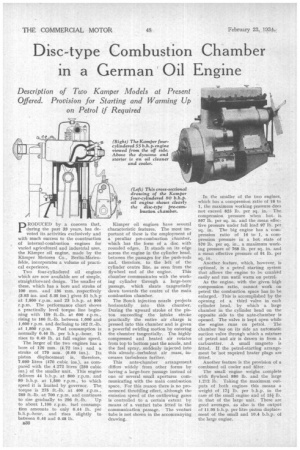Disc-type Combustion Chamber in a German Oil Engine
Page 44

If you've noticed an error in this article please click here to report it so we can fix it.
Description of Two Kam per Models at Present Offered. Provision for Starting and Warming Up on Petrol if Required
RODUCED by a concern that, during the past 33 years, has de voted its activities exclusively and with much success to the construction of internal-combustion engines for varied agricultural and industrial uses, the Kimper oil engine, made by the 'Camper Motoren Co., Berlin-Marienfelcte, incorporates a volume of practical experience, Two four-cylindered oil engines which are now available are of simple, straightforward design. The smaller of these, which has a bore and stroke of 100 mm. and 136 mm. respectively <3.93 ins. and 5.35 ins.) gives 51 b.h.p at 1,800 r.p.m. and 23 b.h.p. at 800 r.p.m. The performance chart shows a practically level torque line beginning with 159 ft-lb. at 600 r.p.m., rising to 166 ft.-lb. between 1,000 arid 1,600 r.p.m. and declining to 162 ft.-lb. at 1,800 r.p.m. Fuel consumption is normally 0.46 lb. per b.h.p.-hour. It rises to 0.49 lb. at full engine speed.
The larger of the two engines has a bore of 120 mm. (4.72 ins.) and a stroke of 170 mm. (6.69 ins.). Its piston displacement is, therefore, 7.690 litres (470 cubic ins.), as compared with the 4.272 litres (250 cubic ins.) of the smaller unit. This engine delivers 44 b.h.p. at 800 r.p.m. and 80 b.h.p. at 1,500 r.p.m., to whic,h speed it is limited by governor. The torque is 275 ft.-lb. at 400 r.p.m., 289 ft.-lb. at 700 r.p.m. and continues to rise gradually to 296 ft.-lb. Up to about 1,100 r.p.m. fuel consumption amounts to only 0.44 lb. per b.h.p.-hour, and rises slightly to between 0.46 and 0.48 lb.
B30
Kamper oil engines have several characteristic features. The most important of these is the employment of a peculiar pre-combustion chamber, which has the form of a disc with rounded edges. It stands on its edge across the engine in the cylinder head, between the passages for the push-rods and, therefore, to the left of the cylinder centre line, as seen from the
flywheel end of the engine. This chamber communicates with the working cylinder through a large-bore passage, which slants tangentially down towards the centre of the main combustion chamber.
. The Bosch injection nozzle projects horizontally into this chamber. During the upward stroke of the piston succeeding the intake stroke practically the entire air charge is pressed into this chamber and is given a powerful swirling motion by entering the chamber tangentially. The highly compressed and heated air rotates from top to bottom past the nozzle, and the fuel spray, suddenly injected into this already-turbulent air mass, increases turbulence further.
This ante-chamber arrangement differs widely from other forms by having a large-bore Passage instead of one or several small apertures communicating with the main combustion space. For this reason there is no pronounced throttling effect, although the emission speed of the outflowing gases is controlled to a certain extent by means of a venturi tube fitted in the communication passage. The venturi tube is not shown in the accompanying drawing.
In the smaller of the two engines, which has a compression ratio of 18 to 1, the maximum working pressure does not exceed 825 lb, per sq.. in.— The compression pressure when hot is 597 lb, per sq. in. and the mean effective pressure under full load 97 lb. per. sq. in. The big engine has a compression ratio of 16 to 1, a compression pressure in a hot state of 570 lb. per sq. in., a maximum working pressure of 768 lb. per sq. in. and a mean effective pressure of 91 lb. per sq. in.
Another feature, which, however, is • optional, is a petrol starting system that allows the engine to be cranked easily and run until warm on petrol.
As the engine, with the given high compression ratio, cannot work on petrol the combustion space has to be enlarged.. Thisis accomplished by the opening of a third valve in each cylinder head, by which a large chamber in the cylinder head on the opposite side to the ante-chamber is opened. The valve is kept open while the engine runs on petrol. The chamber has on its side an automatic suction valve through which a mixture of petrol and air is drawn in from a carburetter. A small magneto is fitted. If the petrol-starting arrangement be hot required heater plugs are fitted.
Another feature is the provision of a combined oil cooler and filter, The small engine weighs complete with flywheel 880 lb. and the large 1,212 lb. Taking the maximum outputs of both engines this means a weight of 17i lb. per b.h.p. in the case of the small engine and of 151 lb. in that of the large unit. These are good averages, as also is the output of 11.95 b.h.p. per litre piston displacement of the small and 10.4 b.h.p. of the large engine.




























































































